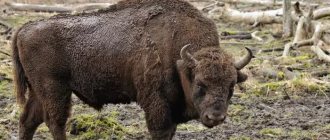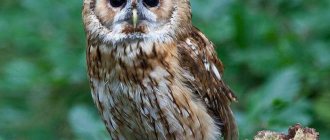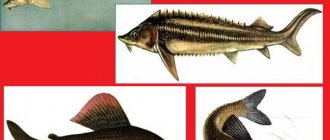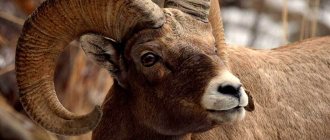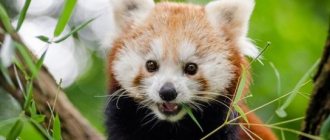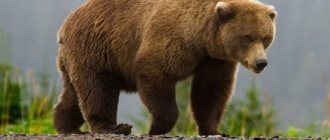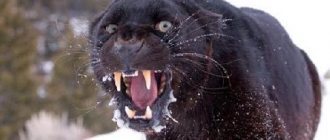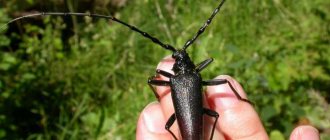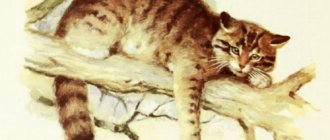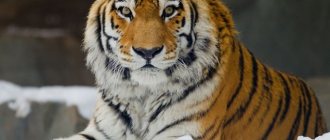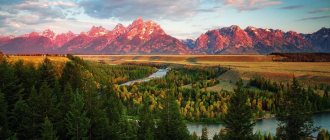The bison is the largest land mammal, both in Europe and in Russia, and is a direct descendant of the genus Bison in the subfamily Bovinae.
The weight of adult males living in the wild is 530–840 kg. Sometimes the weight of adults reaches 1t. Females weigh a little less - 320–540 kg. Their body length is 330 cm, height is up to 2 m. The animal reaches its maximum size by 5-6 years. They live on average 23-26 years. The fur is dark brown.
Where the neck meets the body they have a large hump, which makes the bison’s body even more enormous and gives them a terrifying appearance. The back of their body is significantly smaller in size than the front, and is covered with short hair of a lighter shade. These animals do not have very long limbs, but they are quite strong and have well-defined muscles.
Bulls have a heavier head and a larger hump than cows. Females, like males, have horns, and they use them for fighting. The males' horns are slightly thicker, wider and spaced further apart.
Interesting things about bison
The main task of males is to protect the herd from predators and various enemies. Thanks to highly developed hearing and a keen sense of smell, these giants sense danger long before the moment when it is visible. Bison can detect an uninvited guest at a distance of more than 3 km only by smell.
Despite their enormous size, weight and strength, these animals are quite fast and agile. They easily overcome obstacles up to 2 meters high, and also reach speeds of up to 50 km/h.
An interesting fact is that bison are excellent swimmers and can swim long distances.
Where do they live, what do they eat?
The bison is an animal that lives in spacious forests, sparse meadows and forest edges with good grass cover. Temperate climate zones, where there is no heat or drought, are suitable for it.
This mighty giant with an impressive appearance is harmless not only to humans, but also to all animals living in the forest. While the European bison has a good sense of smell, hearing and, especially, vision are poorly developed. This animal from the Red Book feeds on vegetation: tree bark, grasses, young shoots, leaves, branches of bushes. Every day a bull eats about 50 kg of woody grass feed.
Depending on the season, these herbivores prefer different diets. In spring and summer, it is based on herbaceous greens; in autumn, they like to eat oak shoots and bark, acorns, and happily feed on mushrooms and berries.
In winter, when the grass disappears, they switch to the shoots and bark of deciduous trees, digging out mosses and lichens under the snow with their hooves. Morning and evening hours are reserved for feeding and drinking water, when insects are not so annoying. The rest of the time the animal sleeps.
Social groups
In the wild, bison are known to form large herds. Groups of bison do not form family units, and mixed groups are the main units of their population, including cows, young males and females between two and three years of age, calves and sometimes adult bulls. The average group size is 20 individuals and is led by a dominant female. Around the end of April, large winter herds split into smaller groups averaging 12 bulls, with mature bulls becoming solitary or forming small groups of up to three bulls before rejoining the herd during the rut from August to October. Having no territorial affiliation, groups of bison can meet with each other, and individual individuals sometimes move from one group to another.
Origin of the species
Bison are the last representatives of wild bulls living in Europe. Many experts argue that bison descended from bison, as animals that lived on Earth many millions of years ago. They belong to the bovid family and represent ungulate herbivores.
Based on historical information, we can say with complete confidence that bison existed already in the Ice Age and people in those distant times hunted these mammals. This is also evidenced by rock paintings that have survived to this day. The ancient Egyptians, as well as the Romans, mentioned this powerful and amazing animal. It is also known that in the Roman Empire, bison were used in fights with gladiators.
Food and habitat
The bison is a ruminant animal that consumes both grass and more fibrous foods. Their digestive system requires regular and frequent meals, which are interrupted by rest and chewing.
Animal diet:
- lichens;
- muscle;
- flakes;
- grass;
- young shrubs;
- canes;
- lush green leaves.
Calves consume 8.5 kg daily, while adults can eat more than 30 kg. in a day. The bison is an intermediate herbivore, which means that its diet includes bark and branches in addition to more than 200 different plant species. Bison avoid areas with excessively wet conditions, insufficient water, steep slopes, prolonged snowfall, and deep snow. In winter, bison head into the valleys, where they efficiently forage for food with their hooves by digging through the snow. They are perfectly adapted to survive even in persistent frosts down to -25 and below. Bison prefer to live in deciduous or mixed forests, but not in alder or completely coniferous forests.
Short description
The bison from the Red Book is considered the largest land mammal on earth by its mass. Its body reaches more than three meters in length, and the height at the withers is over 190 cm. At the same time, it has enormous mass: in males the weight reaches 700 kg, in females – up to 500 kg.
The body structure is a powerful front part, which consists of a massive head, a short neck with a prominent hump and a broad chest. The rear is significantly lower and narrower. The legs are strong and stocky with convex hooves. The long tail is covered with thick hair and ends in a tuft of hair. The head, set deep to the bottom, with a wide forehead and short ears, is crowned with curved horns, pointed at the top.
The terrifying appearance of the bison from the Red Book is complemented by thick long hair and a dark brown mane on the chest. Wool has the property of not allowing water to pass through and reliably protects the animal from cold and dampness. The bison's entire body is covered with wool protection. The European bison differs from the Caucasian bison in its brown color with a grayish-brown tint. This one is darker and has a chocolate tint. In winter, the fur on the bison darkens, becomes thicker and curlier.
Regional Red Books
Many constituent entities of the Russian Federation have published their own regional Red Books. This was done to give greater importance to the protection of rare species of animals, birds and plants in the regions. Of course, not all of these species are significant on a global scale. But the local flora and fauna are no less important for the population living there than an individual endangered species on a global scale.
However, some species of animals from the regional Red Books are of global importance. For example, bison. The Red Book of the Krasnodar Territory includes this animal. Because the habitat of bison in Russia also extends to the basins of the Belaya and Malaya Laba rivers, part of which is located in the Krasnodar Territory. And now there are very few of them there. But in the mid-19th century, bison in the Kuban region were not uncommon. The Red Book now warns of careful treatment of these animals.
In addition, in Russia, the school educational program aims not only to instill in children a love for their native land, but also to cultivate a caring attitude towards representatives of flora and fauna. One of the most colorful among them is the bison. The Red Book for Children in pictures demonstrates it in all its glory. This is a clear example of how, without protection, beautiful animals can disappear from the face of the earth.
bison
The female carries the baby for 9 months. As a rule, one calf is born, much less often 2. The weight of a baby cat at birth is about 19-25 kg. The color of a newborn's fur varies depending on the species. In the Belovezhskaya population, bison have a beige tint, in the Caucasian population they have a reddish tint. During the first year of life, the baby feeds on mother's milk and practically does not leave her side.
Population status, animal protection
Currently, the initial stage of work aimed at preserving the European bison has been completed, so this still rare artiodactyl animal is not in danger of extinction in the near future . However, according to the IUCN Red List, this species is classified as vulnerable or “VU”. In the Russian Red Book, bison are classified as animals that are in danger of complete extinction.
Today, zoologists are engaged in saving the European bison population, so the total number of artiodactyl animals of this species is approximately three thousand individuals. Some of the European bison are kept in various zoological parks, and a sufficient number are released into protected natural areas, the largest of which is the well-known Belovezhskaya Pushcha nature reserve.
Return to content
Interesting Facts
The bison is a very timid animal and runs away at the sight of a person. Since he is quite short-sighted, he does not easily see the figure of a person, and when the wind blows away from him, he is forced to approach, his curiosity being mistakenly interpreted by people as preparation for an attack. The bison makes a quiet grunt, which when frightened is replaced by a snort; an irritated animal makes a rumbling sound.
The First World War, civil war, intervention and years of devastation had a tragic impact on the remaining bison population: despite the creation of the Caucasus Nature Reserve, despite the protection in Belovezhskaya Pushcha, the bison herd quickly melted away. The denouement came soon. “The last free bison of Belovezhskaya Pushcha was killed on February 9, 1921 by the former forester of the Pushcha, Bartolomeus Shpakovich: let his name, like the name of Herostratus, be preserved for centuries!” - wrote Erna Mohr, a prominent German zoologist. The Caucasian bison did not survive their Belovezhskaya brothers for long: in 1923 (according to other sources - in 1927), the last of them fell victim to poachers in the Tiginya tract. The bison as a species ceased to exist in natural conditions. Fortunately, by this time a number of bison remained in zoos and private property. In 1923, the International Society for the Conservation of the Bison was created. It conducted an inventory of the remaining bison: there were only 56 of them, of which 27 were males and 29 were females. Painstaking and labor-intensive work began to restore numbers, first in Belovezhskaya Pushcha in Poland, in zoos in Europe, and later in the Caucasus and in Askania-Nova. An international stud book was published and each animal was assigned a number. The Second World War interrupted this work; some of the animals died in the catastrophe that befell the world. However, after the end of the war, the struggle to save the zubpa resumed with renewed vigor. In 1946, bison began to be bred on the territory of Belovezhskaya Pushcha, which belongs to the Soviet Union (by this time, 17 bison remained on Polish territory, which were collected in a special nursery). In 1948, the Central Bison Nursery was organized in the Prioksko-Terrasny Nature Reserve, where some of the bison were transferred to semi-free keeping. From here, part of the breeding material was brought to other reserves of the country (Khopersky, Mordovian, Oksky, etc.). In Belovezhskaya Pushcha and in the Caucasian Nature Reserve, it has become possible to free-range bison, and the Caucasian herd now numbers about 1,500 animals (some of the animals, however, are of hybrid origin). The total number of purebred bison in all reserves and nurseries in the world is more than 3,000 animals. Outside of protected areas, however, there are no bison anywhere. (www.floranimal.ru)
Adult bison have virtually no natural enemies, although wolves can pose a danger to young people. Bison often died from epizootics brought in by livestock (foot-and-mouth disease, anthrax), helminthiasis and other diseases. They also endured snowy winters with great difficulty, suffering greatly from lack of food.
Spreading
The bison inhabited sparse deciduous forests with clearings, forest-steppe and even steppe with floodplain and watershed forests. As humans settled more and more space, bison retreated into the depths of untouched forests. In the steppe zone of Eastern Europe, the bison disappeared in the 16th-17th centuries, in the forest-steppe - at the end of the 17th - beginning of the 18th centuries. In Western Europe it was destroyed much earlier, for example in France - in the 6th century. Driven by human persecution, the bison survived longest in continuous, partly swampy or mountain forests. However, even here he did not find salvation: in 1762 the last bison was killed in the Radnan Mountains in Romania, by 1793 it was destroyed in the mountain forests of Saxony. And only in two places - in Belovezhskaya Pushcha and in the Western Caucasus - did the bison survive in its natural state until the beginning of the 20th century.
Lifestyle
The enormous size of the animal seems clumsy and calm. In fact, the bison always monitors the environment and other animals. When angry, he is incredibly scary and dangerous. First, he warns his victim: he shakes his head, looks straight into the eyes of the enemy, and snorts. Then the bison catches up with the victim and kicks it. If an animal is angry, then neither trees, nor bushes, nor artificial fences will stop it.
Animals come out to the clearings to graze in the early morning and evening, before sunset. During the day they have other worries:
- wool cleaning;
- chewing gum;
- rest;
- heating under the sun's rays.
The female herd is led by the most experienced female, and she guards the calves and younger cows. Only during the mating season do males come to them. If a group is attacked by predators, then all adult bison unite for protection. The female can fiercely protect her child, so even approaching a small animal is dangerous. In other cases, animals calmly react to humans, and sometimes, due to poor eyesight, they don’t even notice.
In hot weather, bison go deep into the forest; in spring and autumn they live near water bodies. Animals flee from insects in open areas, where they stand for a long time under the cool wind. Before sunset, animals always move to a watering hole.
